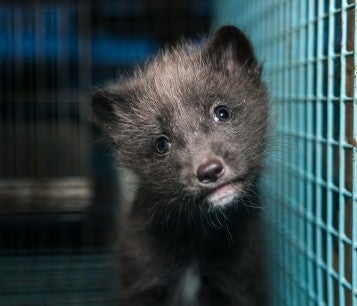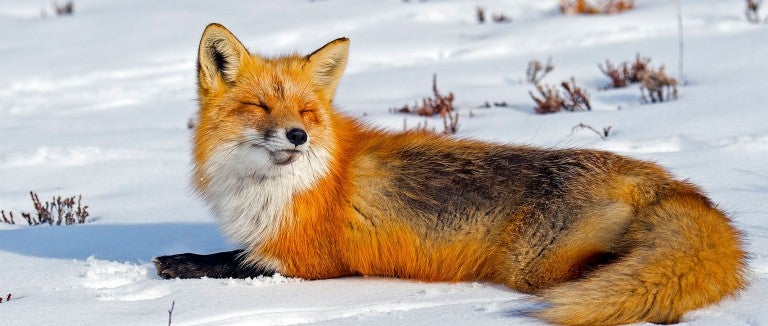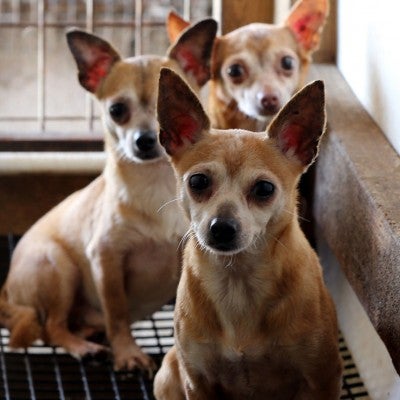Fur factory farms and trappers kill millions of animals each year using brutal methods just for their fur. With your help, the Humane Society of the United States is fighting back—and winning—with brands, cities and countries moving away from fur. But to make progress, we need you.
There are five simple ways you can go fur-free and help stop the unnecessary killing of animals for their fur:
1. Support cruelty-free alternatives
When consumers refuse to purchase animal fur, designers will stop using it, retailers will stop selling it and fashion writers will stop reporting on it as an acceptable trend. You can take a stand with every purchase you make by checking to make sure you're buying animal-friendly materials: Examine the material the hair comes out of to make sure it is woven fabric and not skin, and look at the ends of hairs—they should not be tapered (animal), though blunt ends could be sheared animal fur.
2. Speak up and educate
Spread information about the fur industry with friends and family, on social media, in online comments and in letters to the editor. Share our latest investigation blogs:
- New HSI Investigation Reveals Appalling Cruelty on Fur Farms
- HSI Undercover Investigation Shows Foxes Bludgeoned, Skinned Alive on Asian Fur Farms
- Shocking HSI Investigation Reveals Terror, Suffering of Foxes and Mink on Finland’s Fur Farms
3. Engage in the marketplace
Ask fashion brands, designers and retailers if they have a fur-free policy. If they do, thank them with supportive emails and online comments. If they do not, politely let them know you won’t support them while they profit from cruelty.
4. Follow our progress
Keep up on the latest developments and actions to protect animals from the fur trade on social media and follow our campaign on Facebook.
5. Donate
Please help us continue our ongoing work to stop the fur industry with a generous gift today.
Protect rabbits, foxes, mink and chinchillas from a life of cruelty by shopping fur-free. Several brands and retailers have already joined the fur-free movement to help animals.

Wondering what else to watch out for?
Animals need their fur, feathers and skin more than we do. Many of the animals used for fashion spend their entire lives in cruel conditions, such as cramped cages, and are deprived of the ability to engage in important natural behavior. Fortunately, it’s never been easier to opt out of buying products made from animals. Consumers’ concern for animals is leading top fashion companies to invest in innovative materials that are cruelty-free and more sustainable. Checking our list of fur-free retailers can help ensure your purchases are saving animals from being used and killed for fashion.
Fur, cashmere, wool, shearling, mohair and angora
- Fur: Animal hair with the skin still attached to it.
- Wool: Fleece or hair sheared from an animal—such as a sheep, goat, camel, alpaca, or llama.
- Shearling: The skin of a lamb or sheep, typically with the wool left on.
- Cashmere: Hair sheared from Pashmina goats or other types of goats.
- Mohair: Hair sheared from Angora goats.
- Angora: Fiber or hair taken from Angora rabbits.
Over 100 million animals are killed for their fur annually. The majority of fur comes from fur factory farms where foxes, mink, raccoon dogs and other animals endure life in cramped, wire cages. Other fur comes from animals such as coyotes and bobcats who are cruelly-trapped in the wild.
In the wild, rabbits, goats and sheep only grow enough hair and wool to protect themselves, but since these animals have been bred to produce more hair/wool than they need, they’re sheared. Shearing done on a large scale can be frightening and painful for animals, often resulting in untreated gashes. Angora rabbits often have their hair ripped out of their skin while fully conscious, and because woolly sheep are imported into regions with blowflies that lay their eggs in the thick fleece, the majority of the wool industry often uses a practice called “mulesing,” in which skin is flayed off the sheep’s backside. Male goats and sheep are often castrated and their tails are cut off without pain relief.
Down and silk
-
Down: The fine layer of birds’ feathers found under the tougher exterior feathers.
-
Silk: An animal fiber created by insects and arachnids as building material for cocoons and webs.
Down is obtained by plucking the feathers of a goose or a duck, sometimes while the bird is still alive. The process is extremely painful. Down feathers can also be sourced from birds who are force-fed to produce foie gras—a practice so cruel it’s been banned in New York City and California.
Silk is obtained through sericulture, which is the extraction process used by distributors that entails worms being boiled alive inside their cocoons.
Leather and exotic animal skins
- Leather: Skin from domestic animals such as cows, goats, pigs, cats and dogs.
- Exotic animal skins: Skin from animals such as snakes, lizards, stingrays, alligators, crocodiles and kangaroos.
Most leather is connected to the same animal cruelty and environmental destruction associated with the industrial meat and dairy industries. For exotic skins, animals are either captive bred or captured from the wild. Killing methods such as decapitation and asphyxiation do not result in a quick death, with reptiles often remaining conscious for long periods of time thereafter. Other animals are hit with blows to the head, which stun but may not kill snakes, resulting in the animals being skinned alive. The industry is highly unregulated and illegal trade in exotic skins remains a huge threat globally.
Humane fashion alternatives
It’s not humane to wear or decorate with an animal’s skin, fur or other parts. And with conscious consumers not wanting to support animal cruelty, major fashion companies are offering innovative materials that look and feel like leather, fur, wool and down but that are animal-free. As Giorgio Armani said, “technological progress [...] allows us to have valid alternatives at our disposal that render the use of cruel practices unnecessary as regards animals.”
You can keep animals out of your shopping by looking for animal-free products like vegan leather and plant-based fur. Some companies are even growing collagen and cell-based leathers or investing in leather made from pineapple, mushrooms or by-products of the wine industry. Down alternatives are lighter, warmer and biodegradable and plant-based fur is now being sustainably made from a corn industry by-product.
As consumers opt for these animal-free materials, designers are using more of them and retailers are offering more of them. You can take a stand with every purchase you make by choosing them. With your help, we can show there is no place for animal cruelty in our wardrobes.

